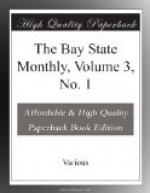That you and your spouse may be directed to do what may be most for the glory of God: and for your own Peace and Comfort, both for time and Eternity: that you may both walk in all the commands and ordinances of the Lord blameless is the Prayer and Desire of your loving uncle.
SHEM DROWNE.
Two of the three best known weather vanes made by Drowne, are still on duty; and one, the Indian chief, which for so many years decked the Province House, is now the property of the Massachusetts Historical Society, in one of the rooms of which it is to be seen, still swinging on its original pivot. From the sole of his foot to the top of his plume, it is four feet, six inches; and from his elbow to tip of arrow, four feet; weight forty-eight pounds.
The old grasshopper on Fanueil Hall[10] was made in 1742, and has veered with the winds and been beaten by the storms of one hundred and forty odd years. It was last repaired in 1852, when there was found within it a much-defaced paper, only a part of which could be read:
SHEM DROWNE MADE ITT
May 25, 1742
To my Brethren and Fellow Grasshoppers
Fell in y’e year 1755 Nov 15th day
from y’e Market by a great Earthquake
... sing ... sett a ... by my old Master
above.
Again Like to have Met with my Utter Ruin
by Fire, but hopping Timely
from my Publick Situation came of with
Broken bones, and much Bruised,
Cured and again fixed....
Old Master’s Son Thomas Drowne June
28th, 1763. And Although I now
promise to Play ... Discharge my
Office, yet I shall vary as ye
wind.[11]
The other one still in use is the old “Cockerel” of Hanover Street Church fame. This was made for the New Brick Church in 1721, and is the oldest of the three. It held its position on this church and its successors, one of which was long known as the “Cockerel Church,” for one hundred and forty-eight years, when it was raised on the Shepard Memorial Church of Cambridge, where it now is. “It measures five feet four inches from bill to tip of tail, and stands five feet five inches from the foot of the socket to the top of comb, and weighs one hundred and seventy-two pounds."[12]
Possibly some other specimens of the handiwork of this good Deacon Shem Drowne are still in existence. Who knows?
[Footnote 1: Boston Globe, October 18, 1884.]
[Footnote 2: Neither of these were carved; they were both of metal.]
[Footnote 3: Boston Evening Record, January 10, 1885.]
[Footnote 4: Fac-similes of his signature are given in “Memorial History of Boston,” vol. II, p. 110, written in 1733, and in John Johnston’s “History of Bristol, Bremen and the Pemaquid Plantation,” p. 466, written in 1762.]
[Footnote 5: Johnston’s “Bristol and Bremen.”]
[Footnote 6: Samuel Adams Drake’s “Old Landmarks of Boston,” p. 135.]




